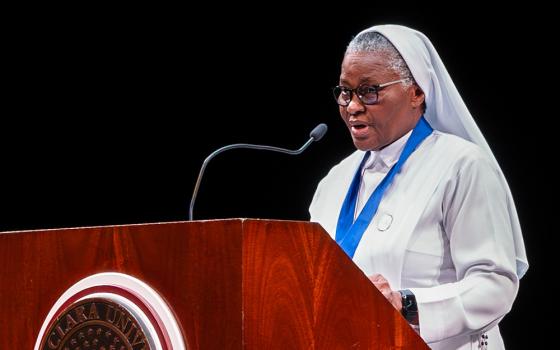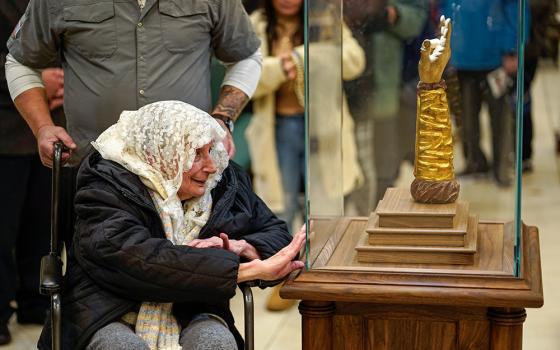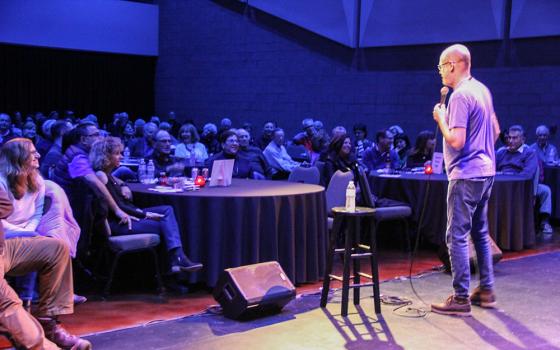Madison Wisconsin's Bishop Robert Morlino, displays, among other items on his coat of arms, a golden turret that, according to the designers of his heraldry, symbolizes a place "in which to take refuge on the journey, to reset ..."
It may be time for the good bishop, after months of contentious interactions with his people, to move, if not to a golden turret of refuge -- the kind many bishops are said to prefer -- then at least to a neutral corner in which to reset his relationships with his people.
The gods of irony wince at the news that in the very week of celebrating the Good Shepherd Morlino has threatened to deny communion, confession, and Christian burial to those of his flock who have objected to their treatment by the self-styled conservative priests of the Spanish Society of Jesus Christ the Priest whom he assigned to parish and other pastoral work in the diocese. (See the NCR news report here.)
The M.O. of this group is not unfamiliar in other parishes in this country. Claiming that Vatican II's decrees "have been misinterpreted," these priests are classic "set-decorator" clerics. Like the set decorators who create detailed old fashioned settings for movies, these clerics attempt to re-create the pre-Vatican II Church in everything from gory crucifixes to sanctuaries so beclouded with clouds of incense that, were they airports, they would be closed to traffic.
They may be kind men but their determination to re-establish a clerically dominated church in the name of orthodoxy leads them, as if in lockstep across the land, to banish girls from serving Mass, issue cease and desist orders to laypeople who have been assisting in the distribution of communion, and to disband the groups that had been bringing communion to the homebound.
The people of St. Mary's parish who complained to Bishop Morlino about this effort to drag the dead weight of early 20th century clericalism into the 21st century church were upbraided by Morlino as possibly guilty of grave sin and of spreading calumny, rumors, and gossip about these priests who also offend the people with their teaching that, after death, non-Catholics go to the nether regions.
This is apparently the kind of non-Catholic Catholicism whose practice, in Morlino's view, guarantees that his "journey" along the episcopal path will lead to ever larger golden turrets of dioceses in which he can reset his dreams of ever more prestigious assignments.
He started in Kalamazoo, Mich., where priests who knew him tell me that he had long ago stamped himself for ecclesiastical greatness. He was always devising or imagining some unorthodox scenario that he could report to Rome. One such incident centered on a pastor who told extraordinary ministers of the Eucharist where, in case of emergency, he kept the key to the tabernacle.
This was just the kind of situation that the ambitious Morlino relished. He took pictures of the tabernacle and the place in which the pastor hid the key and sent them off to Rome with a critique of this allegedly unorthodox behavior. He was ultimately rewarded by being made bishop of Helena, Mont., and, more recently, promoted to Madison, Wis., working his way eastward with what dreams of soon-to-be vacant archdioceses such as Chicago one can readily imagine.
Bishop Morlino, apparently convinced that his super orthodoxy and his willingness to find the needles of heresy in every haystack in rural Wisconsin have advanced his most marked devotion, to himself that is, has involved himself in a series of skirmishes and battles with the flock of which he is supposed to be the Good Shepherd.
He dismissed Mary Kolpak, a pastoral associate in Beloit, Wis., for what he claimed was the unorthodox theme of her 2003 scholarly thesis in which she supported women's rights in the church. In a 10 minute interview, he told her that he had read "bits and pieces" of her master's degree paper, that her teachings about Jesus were "off base," and demanded an oath of loyalty from her and that she denounce her scholarly paper.
She was willing to do the former but unwilling to do the latter. He promptly fired her, allowing the diocesan communications office to trumpet the absolute need for orthodoxy.
There have been other similar incidents in which, even at such poorly timed moments as just before her father's funeral, he insisted that a grieving daughter could not speak at the service. Morlino, it may be said, has made a career out of being an enforcer of orthodoxy. A return to his episcopal coat of arms offers onlookers an insight into how, in the wonderful Roman phrase, he "has made a career in the church."
His motto, taken from the Old Testament Book of Habakkuk (2:3) is Visus non mentietur that may be translated as "The vision will not disappoint." This is as good as a signed confession to what Bishop Morlino has had in mind since he was a little boy in Scranton, Pa. His "vision" has been one of a steady journey upwards to ever more gleaming turrets of gold. His vision may have dispirited many members of his flock but it certainly has not disappointed him.
[Eugene Cullen Kennedy is emeritus professor of psychology at Loyola University, Chicago.]
|
Editor's note: We can send you an email alert every time Kennedy's column, Bulletins from the Human Side," is posted to NCRonline.org. Go to this page and follow directions: Email alert sign-up. If you already receive email alerts from us, click on the "update my profile" button to add Kennedy to your list. |




